初中英语纯英文说课稿
初中英语全英说课稿优秀8篇
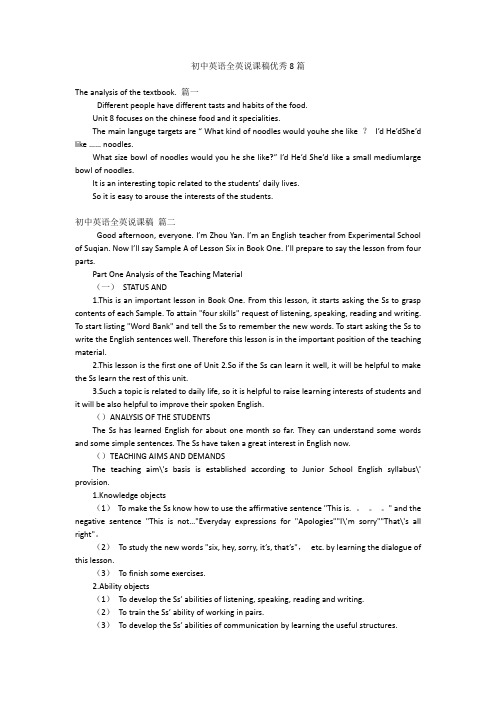
初中英语全英说课稿优秀8篇The analysis of the textbook. 篇一Different people have different tasts and habits of the food.Unit 8 focuses on the chinese food and it specialities.The main languge targets are “ What kind of noodles would youhe she like ?I’d He’dShe’d like …… noodles.What size bowl of noodles would you he she like?” I’d He’d She’d like a small mediumlarge bowl of noodles.It is an interesting topic related to the students’ daily lives.So it is easy to arouse the interests of the students.初中英语全英说课稿篇二Good afternoon, everyone. I’m Zhou Yan. I’m an English teacher from Experimental School of Suqian. Now I’ll say Sample A of Lesson Six in Book One. I’ll prepare to say the lesson from four parts.Part One Analysis of the Teaching Material(一)STATUS AND1.This is an important lesson in Book One. From this lesson, it starts asking the Ss to grasp contents of each Sample. To attain "four skills" request of listening, speaking, reading and writing. To start listing "Word Bank" and tell the Ss to remember the new words. To start asking the Ss to write the English sentences well. Therefore this lesson is in the important position of the teaching material.2.This lesson is the first one of Unit 2.So if the Ss can learn it well, it will be helpful to make the Ss learn the rest of this unit.3.Such a topic is related to daily life, so it is helpful to raise learning interests of students and it will be also helpful to improve their spoken English.()ANALYSIS OF THE STUDENTSThe Ss has learned English for about one month so far. They can understand some words and some simple sentences. The Ss have taken a great interest in English now.()TEACHING AIMS AND DEMANDSThe teaching aim\'s basis is established according to Junior School English syllabus\' provision.1.Knowledge objects(1)To make the Ss know how to use the affirmative sentence "This is. 。
初中英语说课稿范文模板7篇
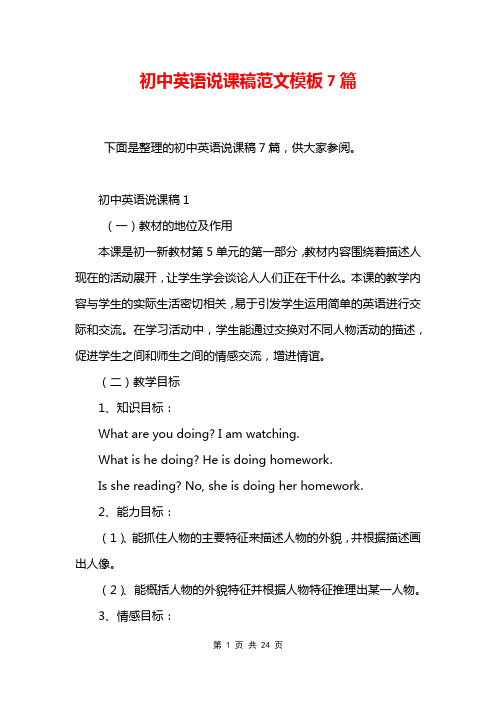
初中英语说课稿范文模板7篇下面是整理的初中英语说课稿7篇,供大家参阅。
初中英语说课稿1(一)教材的地位及作用本课是初一新教材第5单元的第一部分,教材内容围绕着描述人现在的活动展开,让学生学会谈论人人们正在干什么。
本课的教学内容与学生的实际生活密切相关,易于引发学生运用简单的英语进行交际和交流。
在学习活动中,学生能通过交换对不同人物活动的描述,促进学生之间和师生之间的情感交流,增进情谊。
(二)教学目标1、知识目标:What are you doing? I am watching.What is he doing? He is doing homework.Is she reading? No, she is doing her homework.2、能力目标:(1)、能抓住人物的主要特征来描述人物的外貌,并根据描述画出人像。
(2)、能概括人物的外貌特征并根据人物特征推理出某一人物。
3、情感目标:通过描述同学、教师或自己的偶像的外貌,表达自己的看法,使学生在人际交往中学会尊重和理解别人,学会交换不同的看法,了解他人的爱好,增进情谊。
(三)教学重点及难点1、掌握并运用描述人物活动和地点的词汇:watching, doing, eating cleaning, playing, reading, swimming, shopping, pool, school, mall, library2、掌握并运用简单的英语交际句型:What are you doing? I am watching.What is he doing? He is doing homework.Is she reading? No, she is doing her homework.(四)。
教法设计对本课我主要采取了如下几种教法:1.听录音。
听音是英语学习的重要方法,也是课堂教学的重要步骤。
在听中可以感知,可以模仿。
2.重点解释,个别操练。
初中英语全英说课稿优秀9篇
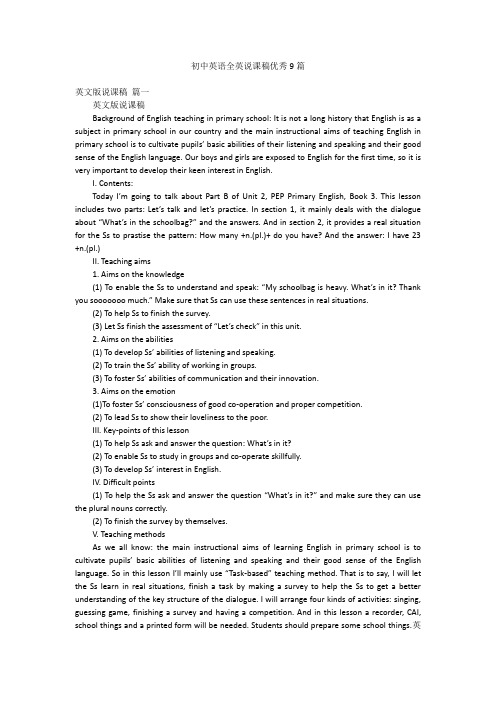
初中英语全英说课稿优秀9篇英文版说课稿篇一英文版说课稿Background of English teaching in primary school: It is not a long history that English is as a subject in primary school in our country and the main instructional aims of teaching English in primary school is to cultivate pupils’ basic abilities of their listening and speaking and their good sense of the English language. Our boys and girls are exposed to English for the first time, so it is very important to develop their keen interest in English.I. Contents:Today I’m going to talk about Part B of Unit 2, PEP Primary English, Book 3. This lesson includes two parts: Let’s talk and let’s practice. In section 1, it mainly deals with the dialogue about “What’s in the schoolbag?” and the answers. And in section 2, it provides a real situation for the Ss to prastise the pattern: How many +n.(pl.)+ do you have? And the answer: I have 23 +n.(pl.)II. Teaching aims1. Aims on the knowledge(1) To enable the Ss to understand and speak: “My schoolbag is heavy. What’s in it? Thank you sooooooo much.” Make sure that Ss can use these sentences in real situations.(2) To help Ss to finish the survey.(3) Let Ss finish the assessment of “Let’s check” in this unit.2. Aims on the abilities(1) To develop Ss’ abilities of listening and speaking.(2) To train the Ss’ ability of working in groups.(3) To foster Ss’ abilities of communication and their innovation.3. Aims on the emotion(1)To foster Ss’ consciousness of good co-operation and proper competition.(2) To lead Ss to show their loveliness to the poor.III. Key-points of this lesson(1) To help Ss ask and answer the question: What’s in it?(2) To enable Ss to study in groups and co-operate skillfully.(3) To develop Ss’ interest in English.IV. Difficult points(1) To help the Ss ask and answer the question “What’s in it?” and make sure they can use the plural nouns correctly.(2) To finish the survey by themselves.V. Teaching methodsAs we all know: the main instructional aims of learning English in primary school is to cultivate pupils’ basic abilities of listening and speaking and their good sense of the English language. So in this lesson I’ll mainly use “Task-based” teaching method. That is to say, I will let the Ss learn in real situations, finish a task by making a survey to help the Ss to get a better understanding of the key structure of the dialogue. I will arrange four kinds of activities: singing, guessing game, finishing a survey and having a competition. And in this lesson a recorder, CAI, school things and a printed form will be needed. Students should prepare some school things.英文版英语说课稿VI. Teaching procedures and purposes of my designing.I’ll finish this lesson in five steps.Step 1. Warm-up and preview1. Free talk between T and Ss about things in the classroom.2. Sing the song together: Books and pencils.3. Do some TPR, for example: Show me your English book. Show me your crayon.4. Review the numbers by asking: “How many crayons do you have?”Purpose: It is important to form a better English learning surrounding for the Ss by singing and doing some total physical response and at the same time it provides situations to review learned knowledge for the next step.Step 2. PresentationNow I’ll mainly talk about this step.1. Present the pattern: “My schoolbag is heavy.” “What’s in it?.”(1) Show a bag and say: “Look! I have a bag.” Carry it and say: “Oh, it is heavy. My schoolbag is heavy.” Help the Ss understand the meaning with the help of my body language. Then lead the Ss to read the sentence. Make sure they can say it correctly.(2) T: My schoolbag is heavy.Open the bag and say: “What’s in it? What’s in my schoolbag?”Take out a Chinese book. Then do the action again. Let the Ss read the sentence.2. Play a guessing game. Divide the whole class into four groups to have a competition.Let them guess: What’s in the bag? How many? Purpose: To present the key structures one by one is much easier for the Ss to learn and grasp the meanings. Proper competition can arouse the Ss’ interest in English learning.3. With the help of the CAI to present the dialogue. Set a situation to help Ss understand: Two Ss are coming. One girl is carrying a heavy bag on her back. They are talking.Girl: My schoolbag is heavy.Boy: What’s in it?Girl: 20 story-books, 32 pencil, 9 rulers, 12 crayons and 30 picture-books. Etc.Boy: What will you do?Girl: They are for the poor.Boy: Great! I’ll bring some school things too.The boy comes back home and puts a lot of things into the bag. Then he goes to school again and gives them to a teacher. While he is taking them out, he is counting the numbers of all things. The teacher says: Thank you soooooooo much.4. Mention that we should take care of the poor.5. Play the cassette. Let the Ss listen and imitate the dialogue.Pay attention to their pronunciation and intonation. Purpose: CAI can provide a real situation for the Ss to understand the dialogue and the relationships between people better. Tell the Ss we should show our loveliness to the Ss.Step 3. PracticeDivide Ss into groups of six children. Each one would finish the printed form by asking and answering: How many storybooks do you have? Find out which group finishes faster. Story books picture-books sharpeners crayons pencils erasers pencil-cases rulers Chen Jie 8 24 3 32 26 4 1 3Purpose: Task-based teaching method is used here to develop Ss’ ability of communication and also their ability of co-operation will be well trained.Step 4. AssessmentHelp Ss finish “Let’s check” of this unit and workbook.Purpose: To check the knowledge Ss have learned in this period.Step 5. Add-activity1. Let Ss tell each other how many school things they have after class. Tell their parents how many school things they have at home.2. Take care of everything they have.Purpose: Revision is so important that Ss should speak English as much as they as in class or after class. It is necessary for the Ss to do some extensive exercises after class to consolidate the knowledge they learned.英文版英语说课稿初中英语说课稿篇二今天我的说课内容是新目标英语八年级上册第四单元第一课时。
初中英语说课稿(集锦15篇)

初中英语说课稿(集锦15篇)初中英语说课稿1一、说教材本单元以“A picnic”为话题,共设计四大部分的内容。
以It must belong to carla为主线,围绕谈论某东西属于某人等语言功能展开一系列任务活动。
通过第一部分的学习要求学会如何进行推测,并了解学会基本句型的应用。
教材内容从基本语言知识到语言综合知识的运用,层层递进,以一种循序渐进的生活化的语言程序,引导学生在做事中有目的的学习语言。
教学目标:知识目标:能够让学生掌握重点的词汇和语言结构。
能力目标:培养学生听、说、读、写能力和观察事物的能力。
情感目标:培养学生在外野营时,不能乱扔。
乱丢垃圾的良好习惯,以确保环境的干净和清洁。
二、说教法以任务教学策略为主,采用情景教学法、听力训练法、并辅助个人,小组竞赛和图片等兴趣策略教学。
如在教授单词时,通过一些图片等进行分析教学,以至于从视角引起他们的注意,从而记注单词。
采取任务型教学策略的目的是让学生多练多用,在做中学,学中乐,乐中掌握。
三、说学法采用合作式学习方式,有目的的让学生预习,在完成任务的活动中主动的学习语言。
养成继续学习英语、学好英语的良好习惯。
并让学生学会如何推测,以至于在做推测性的阅读题时有很好的方法。
强调学生不仅在课上积极发言、多练,并鼓励他们课后成立英语学习兴趣小组、英语角等,积极参加训练。
四、说教学过程1、课前任务设置。
在每一节课,我让学生提前预习,课前三分钟,我让学生学唱“Are you sleeping ”的歌曲。
目的是激发他们的学习热情。
另一方面,铃声响的时候,首先检查学生对第四单元的识记情况。
然后让学生看屏幕,用“Who is he ?” 句子问,用“It can?t、may 、must be ”等回答,之后通过“Look and learn”推出新单词“belong、belong to” 和教授的单元。
在此期间,让学生感知的重点句型结构。
把单词的教学融入句型,培养学生情景中理解单词的能力。
初中英语说课稿范文五篇
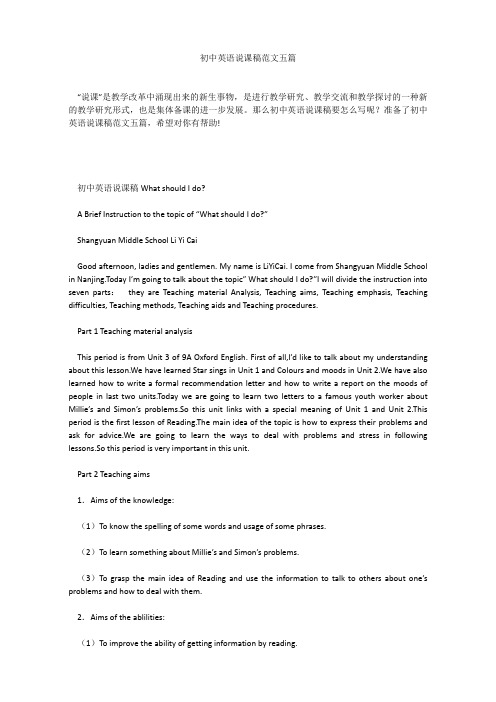
初中英语说课稿范文五篇“说课”是教学改革中涌现出来的新生事物,是进行教学研究、教学交流和教学探讨的一种新的教学研究形式,也是集体备课的进一步发展。
那么初中英语说课稿要怎么写呢?准备了初中英语说课稿范文五篇,希望对你有帮助!初中英语说课稿What should I do?A Brief Instruction to the topic of “What should I do?”Shangyuan Middle School Li Yi CaiGood afternoon, ladies and gentlemen. My name is LiYiCai. I come from Shangyuan Middle School in Nanjing.Today I’m going to talk about the topic” What should I do?”I will divide the instruction into seven parts:they are Teaching material Analysis, Teaching aims, Teaching emphasis, Teaching difficulties, Teaching methods, Teaching aids and Teaching procedures.Part 1 Teaching material analysisThis period is from Unit 3 of 9A Oxford English. First of all,I’d like to talk about my understanding about this lesson.We have learned Star sings in Unit 1 and Colours and moods in Unit 2.We have also learned how to write a formal recommendation letter and how to write a report on the moods of people in last two units.Today we are going to learn two letters to a famous youth worker about Millie’s and Simon’s problems.So this unit links with a special meaning of Unit 1 and Unit 2.This period is the first lesson of Reading.The main idea of the topic is how to express their problems and ask for advice.We are going to learn the ways to deal with problems and stress in following lessons.So this period is very important in this unit.Part 2 Teaching aims1.Aims of the knowledge:(1)To know the spelling of some words and usage of some phrases.(2)To learn something about Millie’s and Simon’s problems.(3)To grasp the main idea of Reading and use the information to talk to others about one’s problems and how to deal with them.2.Aims of the ablilities:(2)To improve the ability of retelling the story.3.Aims of the emotion:(1)To understand how to write about problems and to express feelings.(2)To ask for advice to solve the problems.Part 3 Teaching emphasis1.To master the ‘to’-infinitives and ‘wh-’words+‘to’-infinitives.2.To get the ability of general reading and getting information.Part 4 Teaching difficulties1.To recognize and understand vocabulary about problems.2.To ask for advicePart 5 Teaching methodsIn this topic,I will use five-step Teaching Method and Task-based language Teaching.I design some tasks to help the students learn.I think if I want to improve the students’ oral English,I should give them enough chances to practice and I will use pair work,group work to let the students take an active part in all kinds of activities.That is “Learning by doing,learning by using”.Let the students be the masters of the class teaching,thus,student-centered teaching method is well shown.Part 6 Teaching aidsProjector,slide show,tape recorder and blackboardPart 7 Teaching procedureStep Ⅰ.Lead-inThe purpose is to arouse the students’interest of study.Let’s have a free talk.T:Have you got problems?S:Yes.S:Eating too much makes me unhealthy.T:What about you?S:……Step Ⅰ.PresentationThe purpose is to develop the skills of skimming and how to gain the main idea of the articles. 1.Ask students to read two letters and answer the following questions:①What is Millie’s favorite hobby?(Painting)②What is Millie’s problem?(She doesn’t have enough time for hobbies and home work.)③When does Simon play football?(After school until late)④How do his parents feel about it?(They don’t like this and ask him to go home before 6 p.m.)2.Ask students if there are words that they do not know.Explain some new words briefly.deal;choice;complete;refuse;accept;spare;doubt;whether;Step Ⅰ.PracticeThe purpose is to develop the skills of scanning and how to gain the details from the articles. 1.Listen to the tape and answer some question about “True”or“False”.2.Ask students to read the articles again and explain some important phrases.How to solve the problems;hand in;on time;at the moment;can’t find any time for my hobbies;feel bad;give up;achieve a balance between the two;hear form;make unhappyStep Ⅰ.Retelling1.Ask students to make sentences with phrases that we have learned.2.Try to retell the outline of the articles.3.Encourage students to say something about themselves.Step Ⅰ.Summary and homeworkThe purpose is to give the students a clear idea of how to express their problems and revise the articles.1.Ask students to revise the words and phrases2.Ask students to write a letter about himself after class.During my teaching,I’ll try my best to get my class alive and encourage the students to talk with each other in English. I think the general aim of English teaching is to improve the ability of using English. And I’ll use this to guide my teaching.Thank you!牛津英语9A Unit 3说课稿一、说教材:1、教材简析:我说课的内容是江苏牛津中学英语教材9A第3单元Teenage problems中的Integrated skills 部分。
初中英语全英说课稿(优秀5篇)
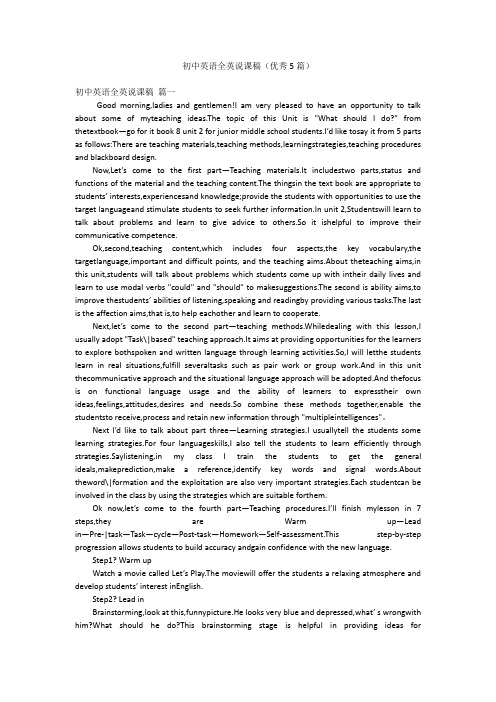
初中英语全英说课稿(优秀5篇)初中英语全英说课稿篇一Good morning,ladies and gentlemen!I am very pleased to have an opportunity to talk about some of myteaching ideas.The topic of this Unit is "What should I do?" from thetextbook—go for it book 8 unit 2 for junior middle school students.I’d like tosay it from 5 parts as follows:There are teaching materials,teaching methods,learningstrategies,teaching procedures and blackboard design.Now,Let’s come to the first part—Teaching materials.It includestwo parts,status and functions of the material and the teaching content.The thingsin the text book are appropriate to students’ interests,experiencesand knowledge;provide the students with opportunities to use the target languageand stimulate students to seek further information.In unit 2,Studentswill learn to talk about problems and learn to give advice to others.So it ishelpful to improve their communicative competence.Ok,second,teaching content,which includes four aspects,the key vocabulary,the targetlanguage,important and difficult points, and the teaching aims.About theteaching aims,in this unit,students will talk about problems which students come up with intheir daily lives and learn to use modal verbs "could" and "should" to makesuggestions.The second is ability aims,to improve thestudents’ abilities of listening,speaking and readingby providing various tasks.The last is the affection aims,that is,to help eachother and learn to cooperate.Next,let’s come to the second part—teaching methods.Whiledealing with this lesson,I usually adopt "Task\|based" teaching approach.It aims at providing opportunities for the learners to explore bothspoken and written language through learning activities.So,I will letthe students learn in real situations,fulfill severaltasks such as pair work or group work.And in this unit thecommunicative approach and the situational language approach will be adopted.And thefocus is on functional language usage and the ability of learners to expresstheir own ideas,feelings,attitudes,desires and needs.So combine these methods together,enable the studentsto receive,process and retain new information through "multipleintelligences"。
初中英语说课稿(优秀6篇)

初中英语说课稿(优秀6篇)初中英语说课稿篇一Cell phone is very popular and used widely recent cell phone,people can,any time,contact friends,talk to families and send blessing SMS to the beloved enjoying so many convineiences,cell phone also has some negative effects on generated by cell phone is harmful to healthy; Specially,ring bells may disturb example,if you are sleeping at noon break in the office,a sudden ring call may shock you from a dream; when all the students are listening to the teacher,a loud ring bell will interrupt the class and make others annoyed; or during a meeting,a call noices is really impolite to other should know where and how to use cell phone properly,and just turn off your phone if it maybe disturbs others.初中英语说课稿篇二Nowadays mobile phones are being more and more popular among the middle school students. Some think it is good for students to bring a mobile phone. But some people do not think so. They think it is bad for students to bring a mobile phone. Because the students will use mobile phones to play games,sent text messages,watch movies,etc which will do harm to their study. And if a mobile phone ring in the class,the teacher and students would be disturbed.In my opinion,we can bring mobile phones to we know,the 21st century is a modern age and full of information. A mobile phone is one of the quickest tools for us to exchange information. The mobile phone is a fashionable and useful invention,so we ought to make the best use of it. Suppose there’s a sudden accident,it is more convenient for us to dial for help immediately. There’re also some games in the mobile phone. We can relax ourselves by playing them when we’re tired of our studies. In my opinion,it’s not wrong to follow the fashion,but the most important thing is how to use the mobile phone in a right way and do not disturbed others.初中英语说课稿篇三In the old China, people were seduced by opium and many people had ruinedtheir lives. Today, China bees stronger and opium has bee the history, butthe new type drug catches people's attention all the time. When we walk aroundthe street, we can find that most people are lowering their heads and playingsmart phone.Smart phone has been the new drug for people, especially for younggeneration. They play it for such a long time that their body health is underthreat. The news has reported many incidents of people feel unfortable afterplaying mobile phones for a long time. We need to use mobile phone in the properway, or we will get into trouble.初中英语说课稿篇四各位评委老师:下午好!一、教材分析1、教材的地位及作用:七年级(下)第三单元,围绕Danny,Jenny,LiMing 和在北京的参观游玩活动为中心,讨论了有关打车,放风筝,照相,给家人写信,发电子邮件,购物的话题。
初中英语说课稿优秀8篇
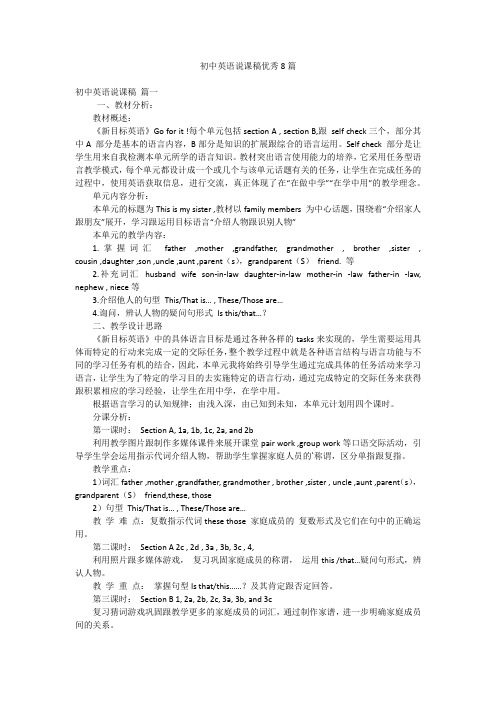
初中英语说课稿优秀8篇初中英语说课稿篇一一、教材分析:教材概述:《新目标英语》Go for it !每个单元包括section A , section B,跟self check三个,部分其中A 部分是基本的语言内容,B部分是知识的扩展跟综合的语言运用。
Self check 部分是让学生用来自我检测本单元所学的语言知识。
教材突出语言使用能力的培养,它采用任务型语言教学模式,每个单元都设计成一个或几个与该单元话题有关的任务,让学生在完成任务的过程中,使用英语获取信息,进行交流,真正体现了在“在做中学”“在学中用”的教学理念。
单元内容分析:本单元的标题为This is my sister ,教材以family members 为中心话题,围绕着“介绍家人跟朋友”展开,学习跟运用目标语言“介绍人物跟识别人物”本单元的教学内容:1.掌握词汇father ,mother ,grandfather, grandmother , brother ,sister , cousin ,daughter ,son ,uncle ,aunt ,parent(s),grandparent(S)friend. 等2.补充词汇husband wife son-in-law daughter-in-law mother-in -law father-in -law, nephew , niece等3.介绍他人的句型This/That is… , These/Those are…4.询问,辨认人物的疑问句形式Is this/that…?二、教学设计思路《新目标英语》中的具体语言目标是通过各种各样的tasks来实现的,学生需要运用具体而特定的行动来完成一定的交际任务,整个教学过程中就是各种语言结构与语言功能与不同的学习任务有机的结合,因此,本单元我将始终引导学生通过完成具体的任务活动来学习语言,让学生为了特定的学习目的去实施特定的语言行动,通过完成特定的交际任务来获得跟积累相应的学习经验,让学生在用中学,在学中用。
- 1、下载文档前请自行甄别文档内容的完整性,平台不提供额外的编辑、内容补充、找答案等附加服务。
- 2、"仅部分预览"的文档,不可在线预览部分如存在完整性等问题,可反馈申请退款(可完整预览的文档不适用该条件!)。
- 3、如文档侵犯您的权益,请联系客服反馈,我们会尽快为您处理(人工客服工作时间:9:00-18:30)。
外研社第八册模块一辅导(-)How Failure Became Success 1.On 8th August ,1914, 27 men who had replied to an advertisement in
The Times boarded a ship leaving for the Antarctic.
1914年8月8日,响应《泰晤士报》上一则广告的27个人凳上了一艘轮船,向南极地区进发。
注意:1) 在具体的哪一天用on .
2)reply 是正式用语,作及物动词用,但后面只跟从句或引语.
Jack replied that he might help me. 杰克回答说他可能会帮助我.
“ I’ll bring some tomorrow ,” Mother replied.
“我明天捎点来,”母亲答道.
reply 作不及物动词用时,后面经常跟介词to reply to 回答:She asked me why I hadn’t replied to her letter.
Answer 日常用语,常用作及物动词,后接名词,代词或从句.例如:
He answered nothing. 他什么也没有回答.
I can’t answer you now. 我现在不答复你.
answer 也可以用作不及物动词,例如:
He did n’t answer. 他没有回答.
3) board vt. 搭乘board a plane 搭飞机
4) leave for sp 出发去某地
2.via 1)经由(by way of ) ,取……途径
We went to London via Siberia. 我们经过西伯利亚到伦敦去.
2) 凭借,通过(by means of ) 以…为媒介
via airmail 以航空邮寄He sent me a love letter via one of my friends. 他通过我的一个朋友把情书寄给了我.
3.But when land came into sight, the Endurance became trapped in the
ice and began to break up. 但当人们看见陆地的时候,“耐力”号却陷在冰块里并开始解体。
1)come into sight 进入视野,看得见
We’ll fire as soon as the enemy come into sight.
敌人一进入视野我们就开火。
相关短语: go out of sight 从视野中消失;变得看不见
lose sight of 失去……的音信,忘记,忽略
catch sight of 看见in sight 在看得见的范围内
out of sight 在看不见的范围之内。
2)break up 碎开,粉碎
The ship broke up on the rocks. 船触礁撞碎了。
关系破裂,中止
Their marriage broke up. 他们的婚姻已破裂.
解散;散去
The meeting broke up at 11 o’clock.
会议是11点散的。
The police used tear gas to break up the demonstration.
警察用催泪瓦斯驱散示威的群众。
4.They then headed north , pulling three life boats behind them.
head 为动词head for 出发向某个地方
5.When they reached the island, Shackleton came up with an idea—it
was a risk but he would have to take it. 他们抵达小岛后,沙克而顿想出一个主意――这是一场冒险,但他得试一试。
1)come up with : think of (a plan, answer, reply…),produce
He couldn’t come up with an answer when I asked why he was late.
Can you come up with a way out?
2)take a risk 冒险
The risk is worth taking, I think.
He took so many risks and succeeded all the time.
6.Shackleton kept his promise. More than three months later, hr returned
to Elephant Island to rescue the crew he had been forced to abandon.
沙而顿没有食言。
三个月后,他回到大象岛解救那些他被迫遗弃的船员。
1)许诺/违背/信守诺言分别是make /break/keep one’s promise 2)crew 通常是指船长以外的全体船员.
7. failure 和success 可以抽象名词具体化. 例如: He is a success. 他是个成功的人. He is a failure. 他是个失败的人.。
